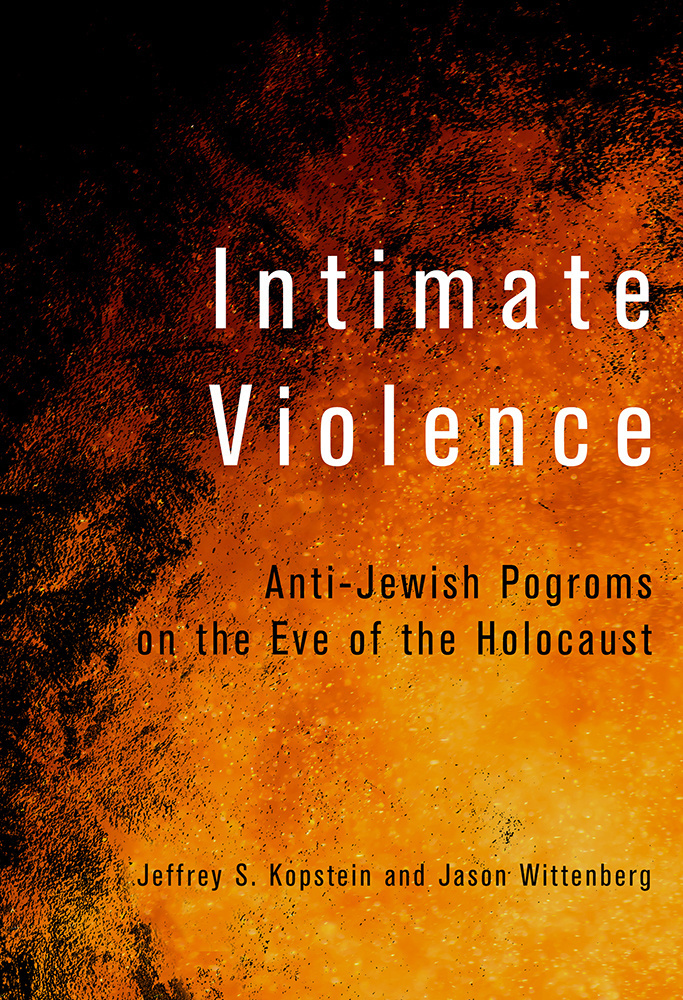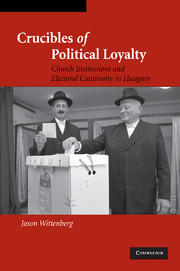 Intimate Violence: Anti-Jewish Pogroms on the Eve of the Holocaust Cornell University Press, 2018. (Co-Authored with Jeffrey S. Kopstein).
Intimate Violence: Anti-Jewish Pogroms on the Eve of the Holocaust Cornell University Press, 2018. (Co-Authored with Jeffrey S. Kopstein).
Winner of the 2019 Bronislaw Malinowski Award in the Social Sciences, given by the Polish Institute of Arts and Sciences of America.
Honorable mention, 2019-2020 prize for the best English-language book in the field of Ukrainian history, politics, language, literature, and culture, awarded by the American Association for Ukrainian Studies.
Why do pogroms occur in some localities and not in others? Jeffrey S. Kopstein and Jason Wittenberg examine a particularly brutal wave of violence that occurred across hundreds of predominantly Polish and Ukrainian communities in the aftermath of the Nazi invasion of the Soviet Union. The authors note that while some communities erupted in anti-Jewish violence, most others remained quiescent. In fact, fewer than 10 percent of communities saw pogroms in 1941, and most ordinary gentiles never attacked Jews.
Intimate Violence is a novel social-scientific explanation of ethnic violence and the Holocaust. It locates the roots of violence in efforts to maintain Polish and Ukrainian dominance rather than in anti-Semitic hatred or revenge for communism. In doing so, it cuts through painful debates about relative victimhood that are driven more by metaphysical beliefs in Jewish culpability than empirical evidence of perpetrators and victims. Pogroms, they conclude, were difficult to start, and local conditions in most places prevented their outbreak despite a general anti-Semitism and the collapse of the central state. Kopstein and Wittenberg shed new light on the sources of mass ethnic violence and the ways in which such gruesome acts might be avoided.
See also: Nazi guards weren’t the only ones killing Jews during the Holocaust. Some — but not all — communities did it themselves first. Why? Washington Post blog, August 22, 2018.
See also: Yes, some Poles were Nazi collaborators. The Polish Parliament is trying to legislate that away. Washington Post blog, February 2, 2018.
Reviewed in The Polish Review, Vol. 66, No. 1, 2021.
Reviewed in Nationalities Papers, Vol. 49, Issue 3, 2020.
Reviewed in Holocaust and Genocide Studies, Vol. 34, Issue 3, Winter 2020.
Reviewed in American Historical Review, Vol. 125, Issue 4, October 2020.
Reviewed in H-Judaic, July 2020.
Reviewed in Journal of Comparative Politics, May 2020.
Reviewed in The Journal of Modern History, Volume 92, No. 1, March 2020.
Journal of Genocide Research 2019 Book Forum reviews: here, here, here, here, here, and here. Our response.
Reviewed in Slavic Review, Volume 78, No. 3, Fall 2019.
Reviewed in European History Quarterly, Volume 49, No. 4, October 2019.
Reviewed in Times of Israel. October 2019.
Reviewed in Sheldon Kirshner Journal. October 5, 2019.
Reviewed in H-New Reviews in the Humanities and Social Sciences. July 2019.
Reviewed in German Studies Review, Volume 42, No. 2, May 2019.
Reviewed in Reviews in History no. 2302. Our response.
Reviewed in Perspectives on Politics, Volume 16, Issue 4, Dec 2018, pp. 1209-1210.
A review in Polish: Zagłada Żydów. Studia i Materiały. Vol. 15, 2019.
A review in Polish: Oczyszczenie narodowców. 219 pogromów na Kresach. August 29, 2018.
A review in Polish: 219 razy Jedwabne. Wstrząsająca książka o pogromach antyżydowskich latem 1941 roku. August 5, 2018.
 Crucibles of Political Loyalty: Church Institutions and Electoral Continuity in Hungary Cambridge University Press, 2006. Paperback reissue 2012.
Crucibles of Political Loyalty: Church Institutions and Electoral Continuity in Hungary Cambridge University Press, 2006. Paperback reissue 2012.
Winner of the 2009 Hubert Morken Award, given by the Religion and Politics section of the American Political Science Association for the best publication dealing with religion and politics published in 2006 or 2007.
This book investigates one of the oldest paradoxes in political science: why do mass political loyalties persist even amid prolonged social upheaval and disruptive economic development? Drawing on extensive archival research and an original database of election results, it explores the paradox of political persistence by examining Hungary’s often tortuous path from pre- to post-communism. It demonstrates how despite the many depredations of communism, the Roman Catholic and Calvinist Churches transmitted loyalties to parties of the Right. Contrary to conventional wisdom, Church resistance occurred not from above, but from below. Hemmed in and harassed by communist party cadres, parish priests and pastors employed a variety of ingenious tactics to ensure the continued survival of local church institutions. These institutions insulated their adherents from pressures to assimilate into the surrounding socialist milieu. Ultimately this led to political continuity between pre- and post-communism.
Reviewed in H-Net Online, January 2010.
Reviewed in The Journal of Modern History, March 2009, Vol. 81, No. 1, pp. 228-232.
Reviewed in Slavonic and East European Review, January 2009, Vol. 87, No. 1, pp. 176-178.
Reviewed in Political Psychology, April, 2008, Vol. 29, No. 2, pp. 300-303.
Reviewed in Slavic Review, Winter 2007, Vol. 66, No. 4, pp. 747-748.
Reviewed in Comparative Political Studies, November 2007, Vol. 40, No. 11, pp. 1398-1402.
Reviewed in Democratization, August 2007, Vol. 14, Issue 4, pp. 757-759.
Reviewed in Perspectives on Politics, June, 2007, Vol. 5, No. 2, pp. 386-388.
Reviewed in Foreign Affairs, January/February 2007.